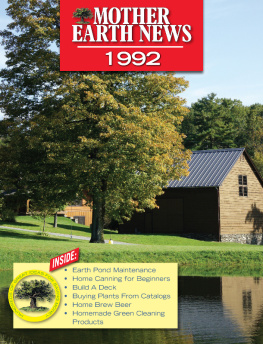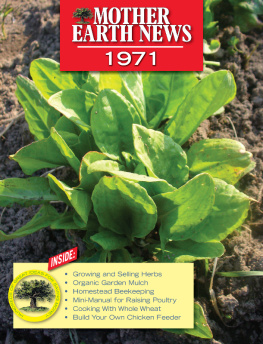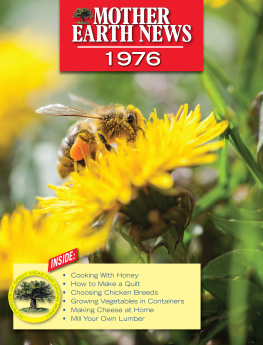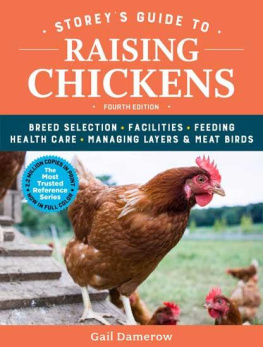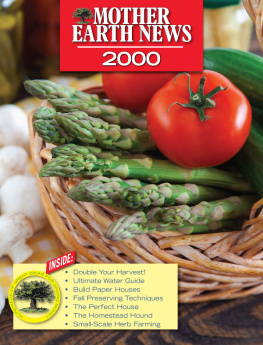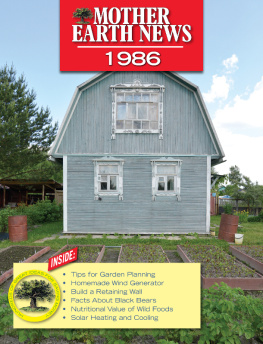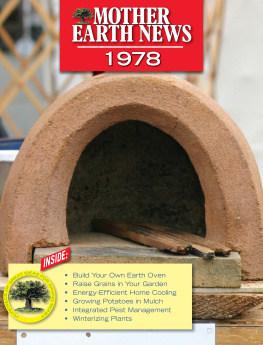Mother Earth News - Mother Earth News 1998
Here you can read online Mother Earth News - Mother Earth News 1998 full text of the book (entire story) in english for free. Download pdf and epub, get meaning, cover and reviews about this ebook. year: 1998, publisher: Mother Earth News, genre: Science / Home and family. Description of the work, (preface) as well as reviews are available. Best literature library LitArk.com created for fans of good reading and offers a wide selection of genres:
Romance novel
Science fiction
Adventure
Detective
Science
History
Home and family
Prose
Art
Politics
Computer
Non-fiction
Religion
Business
Children
Humor
Choose a favorite category and find really read worthwhile books. Enjoy immersion in the world of imagination, feel the emotions of the characters or learn something new for yourself, make an fascinating discovery.
- Book:Mother Earth News 1998
- Author:
- Publisher:Mother Earth News
- Genre:
- Year:1998
- Rating:5 / 5
- Favourites:Add to favourites
- Your mark:
- 100
- 1
- 2
- 3
- 4
- 5
Mother Earth News 1998: summary, description and annotation
We offer to read an annotation, description, summary or preface (depends on what the author of the book "Mother Earth News 1998" wrote himself). If you haven't found the necessary information about the book — write in the comments, we will try to find it.
Mother Earth News 1998 — read online for free the complete book (whole text) full work
Below is the text of the book, divided by pages. System saving the place of the last page read, allows you to conveniently read the book "Mother Earth News 1998" online for free, without having to search again every time where you left off. Put a bookmark, and you can go to the page where you finished reading at any time.
Font size:
Interval:
Bookmark:


Im an American wildlife biologist working in the country of Surinam, South America. Sea turtle conservation is an important part of my work here. As such, I spend a good amount of time on remote nesting beaches, where I often meet fishermen. Through them, I became acquainted with an interesting use of Styrofoam that I want to pass on to you and your readers.
The fishermen collect all kinds of chunks of Styrofoam they find on the beach and make it into a substitute for two-component epoxy to repair their canoes. It works great, and here is how to do it.
Crumble the Styrofoam into dice-size or peanut-size pieces, drop them a few at a time into a container holding a small quantity of gasoline, and watch them dissolve, stirring occasionally. You need very little gasoline, but a lot of Styrofoam. You will have to experiment with it. Start with maybe a 1/16 inch layer of gasoline in a tuna-can sized container. You will be amazed how much Styrofoam you are going to need before the mixture starts to thicken. When it is about the consistency of what you would normally get when mixing two-component epoxy, the mixture is ready for use.
Use it like you would epoxy. It will harden in a couple of hours, and you can work it like wood or metal. You can also melt the Styrofoam in paint thinner, but then it may take 24 to 48 hours to harden; this may be useful for some applications. At any rate, the fishermen in Surinam use it to repair their boats: fill seams, close cracks, repair holes, you name it. - Paramaribo, Surinam
Here is a low-cost trap for whiteflies that enjoy my tomato plants indoors and outside. To make it, clean bright yellow bottles then fill them with water or sand to prevent tipping by wind. Cover them with auto grease or petroleum jelly and then smear on oil. -Paul W. Cover, Hilliard, Ohio
You can recycle an empty, clean, two-liter plastic pop bottle into a transparent bird restaurant. Heres how.
Step One: Cut away about one-third of the neck where the cap threads are. Dont cut beyond the heavy plastic at the end of the threads. Your cut-away will be about 1/4 inch deep by 1/3 to 1/2 inch long. This allows even sunflower seeds to slide through into the feed tray.
Step Two: Cut the bottom off a small Cool Whip-sized container so it makes a dish about an inch deep. This will make the feed tray.
Step Three: Using the tip of a knife or a small drill bit, make two holes across from each other just large enough for the wire, about three inches up the bottle neck. Make two more holes across from each other in the small container bottom about 2-1/2 to 3 inches apart.
Step Four: Pass the wire first through the holes in the bottle so equal lengths stick out on both sides. Bend these ends down to run through the two holes in the feeder tray. Slide the feeder tray up tight against the bottle neck and twist the wire ends together firmly to secure it in place. Trim any excess wire. This end of the feeder is complete.
Step Five: At the other end of the bottle, cut off about three inches evenly. This will be the cover of the feeder. Set this aside for now.
Step Six: Make two slits about a half inch deep and across from each other in the open end of the plastic bottle. This will allow the cover to slide tightly over the open end so rain doesnt get at the feed.
Step Seven: Use the knife tip or small drill bit to make two holes across from each other, three inches down from the open end. Pass the second piece of wire through these holes and leave just enough room to allow you to put on and take off the cover before twisting it together to form a handle-type hanger.
Step Eight: Flip the hanger to the side, fill the feeder with bird feed, and choose a place to hang it where you can watch the birds while they eat. -Beverly Kleikamp,
Powers, Minnesota
I live in the southernmost province of Costa Rica. It is quite hot here all of the time. My home has cement block walls one meter high with nothing from there up to the ceiling but security bars spaced about five inches apart horizontally - no glass.
I recently built a twelve foot long work bench against one of the walls that face my gardens. I needed a place to hang tools but wanted to retain the window. Therefore no pegboard. I solved the problem by wiring half-inch screening to the bars. I make hangers from wire. I have a flexible hanging system, the view of my beautiful gardens, and unrestricted ventilation.
I needed to put up 10 cup hooks but had left my awl on the job. So I cut the head off of a twenty penny nail (4 inch) and, leaving it in the vice, bent it over three-quarters of an inch with a hammer. I then split a 3-1/2 inch length of closet pole, drilled one half of it the appropriate size for the nail and chiseled out a channel to fit the short foot of the L-shaped nail. I taped the two halves of the cylinder back together and now have an awl that actually fits my hand better than the store-bought one. I guess mine cost around two cents. -George H. Presser, Golfite, Costa Rica
With planting season here and summers heat in prospect, the last thing on your mind is the faithful wood-burning plant thats kept you warm all winter. And the most forgettable component of the heating system is the flue: the chimney that created the draft that pulled air through the fire while exhausting the smoke.
Its condition at the end of a winters use can tell you a lot about your woodburning habits and about your plant - good information to have if you still have an older airtight stove and plan to have the chimney serviced by a heating contractor or professional chimney sweep. The best-equipped sweeps now have little video cameras they can lower into your chimney to inspect its inner secrets. But, most also sell expensive new-model stoves, and build or reline chimneys. Their high tech cure for your flues symptoms could cost several thousand dollars when all you really need do is to seal up a few leaks or update your wood-burning routine.
Locate a hand mirror, a flashlight, some grease or a remnant of bar soap, a narrow ash shovel or garden trowel, and a bucket. Take the tools to your flues cleanout. In a modern brick or concrete block chimney this is a small cast-iron door mortared into the chimneys base. Open it carefully; if the hinges are rusted or the door is too gummed-up to open easily, soak all around with penetrating oil. Then, pry open gently; if the thin, brittle iron door cracks, the whole door/frame unit will have to be broken out and a new one mortared in.
Grease or soap the hinges and edges of the door before you close it again for easy opening in the future. Be sure it closes tight and latches firmly; if it wont, bank loose sand up around it. Any significant air leak in the cleanout closure will rob your stove of draft.
If this is the flues first cleaning, the floor of the chimney will most probably contain a pile of loose mortar plus chunks of brick, block, or fireclay liner fallen during construction. If the flue bottom otherwise contains nothing but fine, dry soot, youre running your stove right: with hot, well-oxygenated fires that burn wood completely and emit none of the comparatively cold, wet, sour smelling smoke that will condense inside the flue and dry into creosote that can ignite to produce a flue fire that can burn your house down.
Font size:
Interval:
Bookmark:
Similar books «Mother Earth News 1998»
Look at similar books to Mother Earth News 1998. We have selected literature similar in name and meaning in the hope of providing readers with more options to find new, interesting, not yet read works.
Discussion, reviews of the book Mother Earth News 1998 and just readers' own opinions. Leave your comments, write what you think about the work, its meaning or the main characters. Specify what exactly you liked and what you didn't like, and why you think so.


